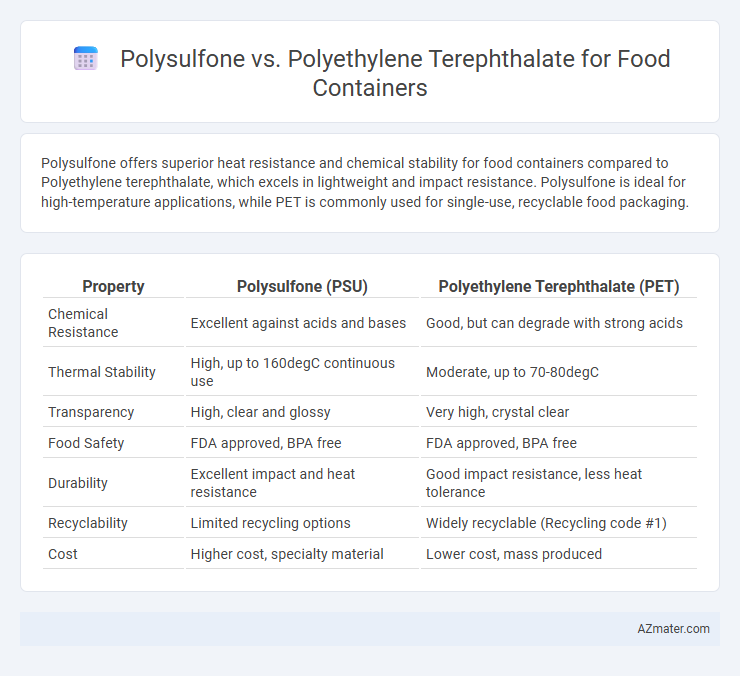Polysulfone offers superior heat resistance and chemical stability for food containers compared to Polyethylene terephthalate, which excels in lightweight and impact resistance. Polysulfone is ideal for high-temperature applications, while PET is commonly used for single-use, recyclable food packaging.
Table of Comparison
| Property | Polysulfone (PSU) | Polyethylene Terephthalate (PET) |
|---|---|---|
| Chemical Resistance | Excellent against acids and bases | Good, but can degrade with strong acids |
| Thermal Stability | High, up to 160degC continuous use | Moderate, up to 70-80degC |
| Transparency | High, clear and glossy | Very high, crystal clear |
| Food Safety | FDA approved, BPA free | FDA approved, BPA free |
| Durability | Excellent impact and heat resistance | Good impact resistance, less heat tolerance |
| Recyclability | Limited recycling options | Widely recyclable (Recycling code #1) |
| Cost | Higher cost, specialty material | Lower cost, mass produced |
Introduction to Polysulfone and Polyethylene Terephthalate
Polysulfone (PSU) is a high-performance thermoplastic known for its excellent thermal stability, chemical resistance, and durability, making it suitable for reusable food containers that require sterilization and heat resistance. Polyethylene terephthalate (PET) is a widely used polyester with good strength, clarity, and barrier properties against moisture and gases, commonly employed in single-use and recyclable food packaging. Both materials offer unique benefits in food safety and preservation, with PSU excelling in high-temperature applications and PET favored for its transparency and cost-effectiveness.
Chemical Structure and Properties
Polysulfone (PSU) features aromatic rings linked by sulfone groups, providing excellent thermal stability, chemical resistance, and mechanical strength, ideal for reusable food containers that require high durability. Polyethylene terephthalate (PET) has an ester functional group in its repeating units with a linear chain structure, resulting in good moisture barrier properties, clarity, and moderate thermal resistance, widely used for single-use food packaging. The rigid aromatic sulfone linkages in PSU offer superior heat tolerance compared to the ester bonds in PET, making PSU more suitable for applications involving repeated heat exposure.
Mechanical Strength Comparison
Polysulfone exhibits superior mechanical strength compared to polyethylene terephthalate, with higher tensile strength and better impact resistance ideal for durable food containers. Polyethylene terephthalate, while offering good stiffness and clarity, tends to have lower mechanical robustness and is more prone to cracking under stress. The enhanced thermal and mechanical properties of polysulfone make it preferable for applications requiring long-term structural integrity and heat resistance in food packaging.
Thermal Resistance and Stability
Polysulfone exhibits superior thermal resistance compared to polyethylene terephthalate, maintaining structural integrity at temperatures up to 160degC, whereas PET typically withstands up to 70-80degC before deformation. The high glass transition temperature of polysulfone contributes to its exceptional thermal stability, making it ideal for applications involving repeated heating or sterilization processes. In contrast, polyethylene terephthalate's lower thermal stability limits its use to cold or room temperature food storage, where it remains chemically inert but less resilient to thermal stress.
Food Safety and Chemical Leaching
Polysulfone exhibits excellent thermal stability and resistance to chemical degradation, making it less likely to leach harmful substances into food compared to polyethylene terephthalate (PET), which can release antimony and acetaldehyde under high temperatures or prolonged storage. Polysulfone's inherent resistance to acidic and alkaline food contents ensures safer food contact applications. PET remains widely used due to its recyclability, but polysulfone provides superior food safety performance when chemical leaching and long-term storage concerns are prioritized.
Reusability and Durability
Polysulfone exhibits superior reusability and durability for food containers due to its high thermal stability and resistance to chemical degradation, allowing repeated sanitization without performance loss. Polyethylene terephthalate (PET) offers good initial strength but tends to degrade with prolonged exposure to heat and repeated use, limiting its longevity in reusable food storage. The structural integrity of polysulfone ensures long-term use, making it a preferred material for durable, reusable food containers compared to PET.
Ease of Manufacturing and Processing
Polysulfone offers excellent thermal stability and chemical resistance, enabling easier processing at high temperatures without degrading, which is advantageous for food container manufacturing requiring sterilization. Polyethylene terephthalate (PET) is highly favored in bulk food container production due to its efficient injection molding and thermoforming capabilities, providing fast cycle times and low energy consumption. The ease of manufacturing PET combined with its cost-effectiveness makes it the preferred choice, while polysulfone remains specialized for applications demanding superior heat and chemical resistance during processing.
Environmental Impact and Recyclability
Polysulfone exhibits higher thermal stability and chemical resistance but poses challenges in recycling due to its complex polymer structure and limited industrial recovery processes. Polyethylene terephthalate (PET) is widely favored for food containers because of its excellent recyclability, supported by extensive collection and recycling infrastructure that reduces environmental impact through effective material recovery. Life cycle assessments reveal PET containers contribute less to landfill accumulation and greenhouse gas emissions compared to polysulfone, making PET a more sustainable choice in food packaging applications.
Cost Efficiency and Market Availability
Polysulfone offers high heat resistance and durability for food containers but comes at a higher cost and limited market availability compared to polyethylene terephthalate (PET). PET dominates the market due to its affordability, widespread production, and excellent recyclability, making it the preferred choice for cost-efficient food packaging. The greater supply chain maturity and lower raw material expenses of PET significantly enhance its economic viability over polysulfone in commercial applications.
Best Applications for Food Containers
Polysulfone exhibits exceptional heat resistance and chemical stability, making it ideal for high-temperature food containers such as microwaveable and dishwasher-safe storage. Polyethylene terephthalate (PET) is preferred for lightweight, clear, and recyclable containers suited for cold food packaging, beverages, and single-use applications. Each polymer serves distinct roles: polysulfone excels in durability and reusability under heat stress, while PET prioritizes clarity, cost-effectiveness, and environmental sustainability for everyday food storage.

Infographic: Polysulfone vs Polyethylene terephthalate for Food container
 azmater.com
azmater.com